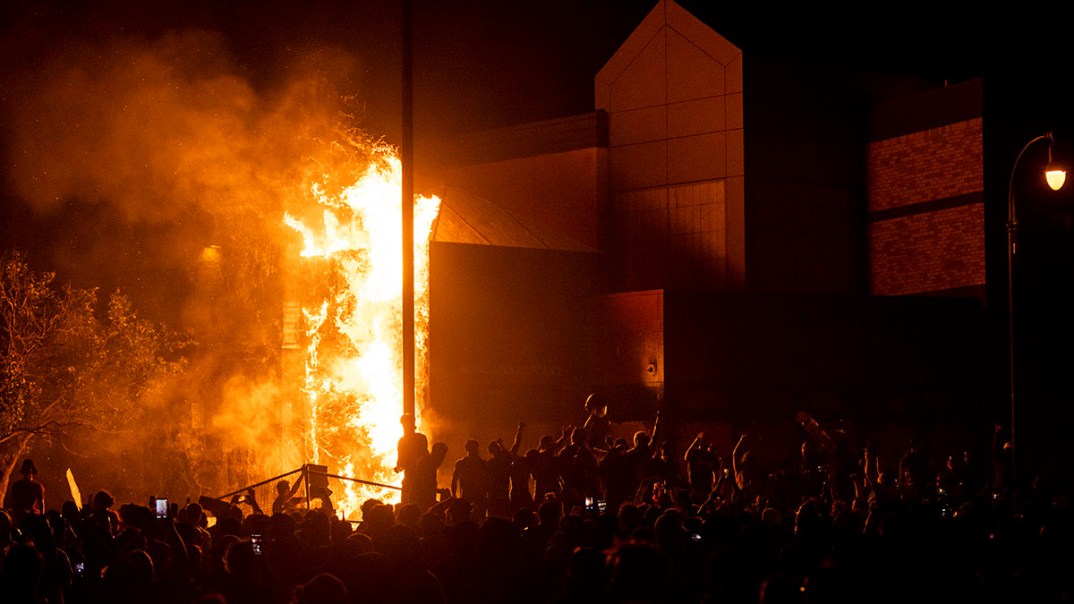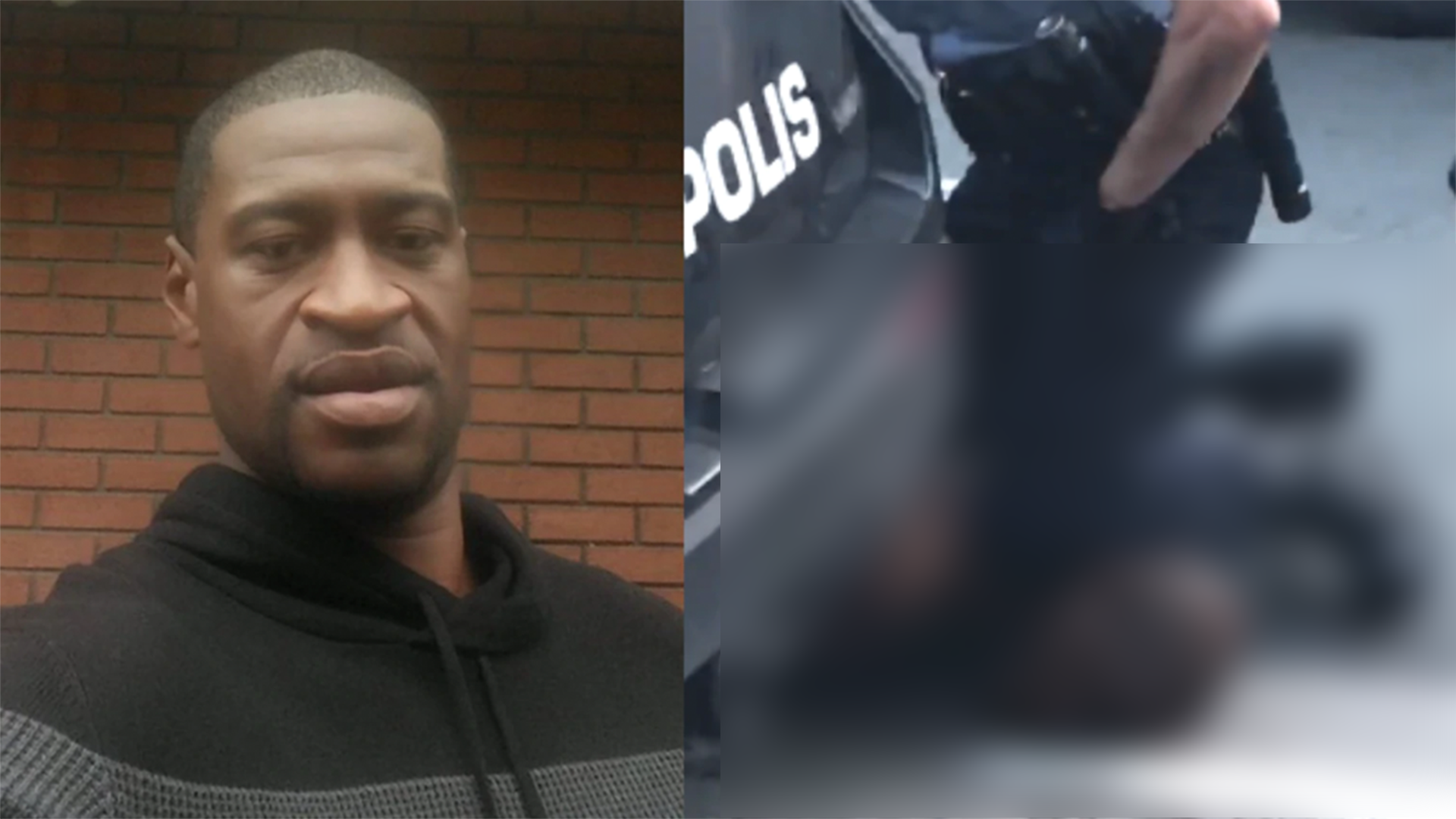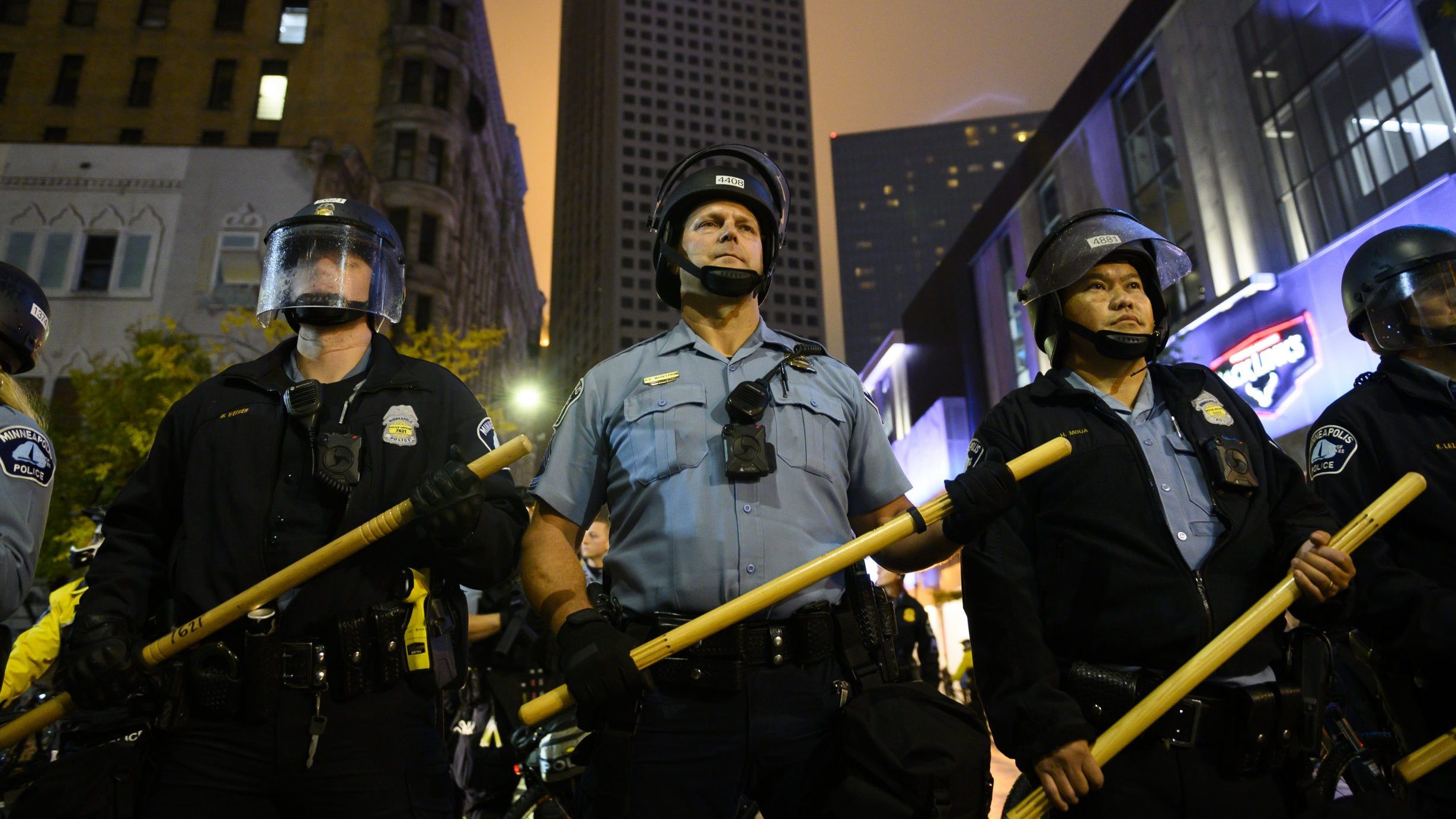Minneapolis police station set afire during George Floyd protests
Individuals reportedly broke into the precinct, setting it ablaze and igniting fireworks amid days of unrest

MINNEAPOLIS (AP) — Cheering protesters broke into a Minneapolis police precinct station on Thursday after the department abandoned it, setting it ablaze and igniting fireworks as three days of violent protests spread to cities across the U.S over the death of George Floyd, a handcuffed Black man.
A police spokesman confirmed late Thursday that staff had evacuated the 3rd precinct station, the focus of many of the protests, “in the interest of the safety of our personnel” shortly after 10 p.m. Livestream video showed the protesters entering the building, where fire alarms blared and sprinklers ran as blazes were set.
READ MORE: Teen who filmed George Floyd’s death says she is traumatized
Mpls Fire Chief John Fruetel learned that the 3rd Precinct Police Department building is on fire from CNN’s Don Lemon during a live interview pic.twitter.com/2OWGRAq56H
— Aaron Rupar (@atrupar) May 29, 2020
Protesters could be seen setting fire to a Minneapolis Police Department jacket and cheering.
Protests first erupted Tuesday, a day after Floyd’s death in a confrontation with police captured on widely seen citizen video. On the video, Floyd can be seen pleading that he can’t breathe as Officer Derek Chauvin, who is white, kneels on his neck. As minutes pass, Floyd slowly stops talking and moving. The 3rd Precinct covers the portion of south Minneapolis where Floyd died.

George Floyd and Minneapolis Police officer assaulting him (Family photo from Ben Crump and Screenshot from incident)
Minnesota Gov. Tim Walz earlier Thursday activated the National Guard at the Minneapolis mayor’s request, but it wasn’t immediately clear when and where the Guard was being deployed, and none could be seen during protests in Minneapolis or St. Paul. The Guard tweeted minutes after the precinct burned that it had activated more than 500 soldiers across the metro area.
Earlier Thursday, dozens of businesses across the Twin Cities boarded up their windows and doors in an effort to prevent looting, with Minneapolis-based Target announcing it was temporarily closing two dozen area stores. Minneapolis shut down nearly its entire light-rail system and all bus service through Sunday out of safety concerns.
In St. Paul, clouds of smoke hung in the air as police armed with batons and wearing gas masks and body armor kept a watchful eye on protesters along one of the city’s main commercial corridors, where firefighters also sprayed water onto a series of small fires. At one point, officers stood in line in front of a Target, trying to keep out looters, who were also smashing windows of other businesses.
https://open.spotify.com/episode/0kHy6RSJjIaBiGeJYFaUBD?t=0

Minneapolis Police create a blockade. (Photo by Stephen Maturen/Getty Images)
Hundreds of demonstrators returned Thursday to the Minneapolis neighborhood at the center of the violence, where the nighttime scene veered between an angry protest and a street party. At one point, a band playing in a parking lot across from the 3rd Precinct broke into a punk version of Bob Marley‘s “Redemption Song.” Nearby, demonstrators carried clothing mannequins from a looted Target and threw them onto a burning car. Later, a building fire erupted nearby.
But elsewhere in Minneapolis, thousands of peaceful demonstrators marched through the streets calling for justice.
READ MORE: George Floyd’s family wants Minneapolis officers charged with murder
Floyd’s death has deeply shaken Minneapolis and sparked protests in cities across the U.S. Local leaders have repeatedly urged demonstrators to avoid violence.
“Please stay home. Please do not come here to protest. Please keep the focus on George Floyd, on advancing our movement and on preventing this from ever happening again,” tweeted St. Paul Mayor Melvin Carter, who is Black.
Please stay home. Please do not come here to protest. Please keep the focus on George Floyd, on advancing our movement, and on preventing this from ever happening again. We can all be in that fight together.
— Melvin Carter (@melvincarter3) May 28, 2020
Erika Atson, 20, was among thousands of people who gathered outside government offices in downtown Minneapolis, where organizers had called a peaceful protest. Many protesters wore masks because of the coronavirus pandemic, but there were few attempts at social distancing.
Atson, who is Black, described seeing her 14- and 11-year-old brothers tackled by Minneapolis police years ago because officers mistakenly presumed the boys had guns. She said she had been at “every single protest” since Floyd’s death and worried about raising children who could be vulnerable in police encounters.
“We don’t want to be here fighting against anyone. We don’t want anyone to be hurt. We don’t want to cause any damages,” she said. “We just want the police officer to be held accountable.”
Hennepin County Sheriff David Hutchinson said the rally had been peaceful and there had been no arrests by late evening.
After calling in the Guard, Walz urged widespread changes in the wake of Floyd’s death.
“It is time to rebuild. Rebuild the city, rebuild our justice system and rebuild the relationship between law enforcement and those they’re charged to protect,” Walz said.
Much of the Minneapolis violence occurred in the Longfellow neighborhood, where protesters converged on the precinct station of the police who arrested Floyd. In a strip mall across the street from the 3rd Precinct station, the windows in nearly every business had been smashed, from the large Target department store at one end to the Planet Fitness gym at the other. Only the 24-hour laundromat appeared to have escaped unscathed.
“WHY US?” demanded a large expanse of red graffiti scrawled on the wall of the Target. A Wendy’s restaurant across the street was charred almost beyond recognition.
Among the casualties of the overnight fires: a six-story building under construction that was to provide nearly 200 apartments of affordable housing.
“We’re burning our own neighborhood,” said a distraught Deona Brown, a 24-year-old woman standing with a friend outside the precinct station, where a small group of protesters were shouting at a dozen or so stone-faced police officers in riot gear. “This is where we live, where we shop, and they destroyed it.” No officers could be seen beyond the station.
“What that cop did was wrong, but I’m scared now,” Brown said.
Others in the crowd saw something different in the wreckage.
Protesters destroyed property “because the system is broken,” said a young man who identified himself only by his nickname, Cash, and who said he had been in the streets during the violence. He dismissed the idea that the destruction would hurt residents of the largely black neighborhood.
“They’re making money off of us,” he said angrily of the owners of the destroyed stores. He laughed when asked if he had joined in the looting or violence. “I didn’t break anything.”
The protests that began Wednesday night and extended into Thursday were more violent than Tuesday’s, which included skirmishes between offices and protesters but no widespread property damage.
Mayor Jacob Frey appealed for calm but the city’s response to the protests was quickly questioned as things started spiraling into violence. “If the strategy was to keep residents safe — it failed,” City Council Member Jeremiah Ellison, who is Black, tweeted. “Prevent property damage — it failed.” On Thursday, he urged police to leave the scene of the overnight violence, saying their presence brings people into the streets.
If the strategy was to:
keep residents safe—it failed
prevent property damage—it failed
None of MPDs actions have accounted for the spread of this infectious disease
Why are our officers firing at people from rooftops?
Why is MPD not acting like they work for Minneapolis?
— Jeremiah Ellison (@jeremiah4north) May 28, 2020
But Eric Kowalczyk, a police captain in Baltimore during the Freddie Gray riots in 2015, generally supported the Minneapolis police strategy to avoid confrontations with protesters when possible, saying heavy-handed police responses are only met with more violence.
“Nobody wants to see their city on fire, but at the same time, you don’t want to see citizens injured by the very police department they are protesting,” he said.
Protests have also spread to other U.S. cities. In New York City, protesters defied New York’s coronavirus prohibition on public gatherings Thursday, clashing with police, while demonstrators blocked traffic in downtown Denver. A day earlier, demonstrators had taken to the streets in Los Angeles and Memphis.
Amid the violence in Minneapolis, a man was found fatally shot Wednesday night near a pawn shop, possibly by the owner, authorities said.
Fire crews responded to about 30 intentionally set blazes, and multiple fire trucks were damaged by rocks and other projectiles, the fire department said. No one was hurt by the blazes.
The city on Thursday released a transcript of the 911 call that brought police to the grocery store where Floyd was arrested. The caller described someone paying with a counterfeit bill, with workers rushing outside to find the man sitting on a van. The caller described the man as “awfully drunk and he’s not in control of himself.” Asked by the 911 operator whether the man was “under the influence of something,” the caller said: “Something like that, yes. He is not acting right.” Police said Floyd matched the caller’s description of the suspect.
The U.S. Attorney’s Office and the FBI in Minneapolis said Thursday they were conducting “a robust criminal investigation” into the death. President Donald Trump has said he had asked an investigation to be expedited.
The FBI is also investigating whether Floyd’s civil rights were violated.
Chauvin, the officer who kneeled on Floyd’s neck, was fired Tuesday with three other officers involved in the arrest. The next day, the mayor called for Chauvin to be criminally charged. He also appealed for the activation of the National Guard.
___
Associated Press writers Steve Karnowski, Jeff Baenen and Doug Glass in Minneapolis, and Gretchen Ehlke in Milwaukee contributed to this report.
Have you subscribed to theGrio’s new podcast “Dear Culture”? Download our newest episodes now!
https://open.spotify.com/episode/2XG71SmYPP80MxutbI1UyO?t=0
https://open.spotify.com/episode/51fhvJHAl0eAcgkg4wBbYf
